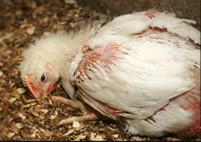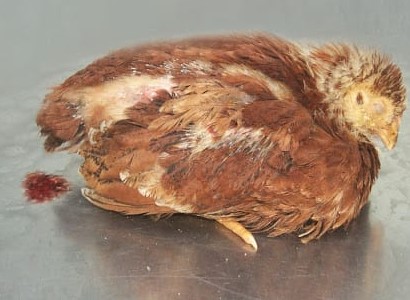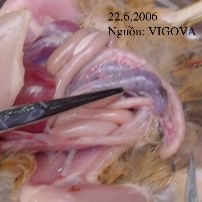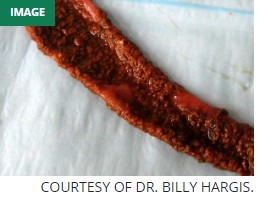AVIUM COCCIDIOSIS
Coccidiosis is a parasitic disease affecting chickens, often breaking out rapidly in damp conditions. It is highly contagious, persistent, and challenging to completely eradicate. In Vietnam, statistics show that coccidiosis causes a 5-15% mortality rate in chickens. Infected chickens are also prone to secondary infections, especially by E. coli, complicating treatment further.
Etiology
The disease is caused by coccidia parasites such as Eimeria tenella, which infects the cecum, and Eimeria necatrix, which infects the small intestine, leading to severe disease. Coccidiosis commonly occurs in chickens aged 10 to 90 days, and occasionally in chickens 4 to 6 months old, with the highest susceptibility and severity in chickens under 90 days. It affects chickens, ducks, turkeys, quails, pheasants, and other bird species. The primary source of infection is infected chickens. Additionally, coccidia can spread through mechanical means by farm workers, wild birds, and rodents.
Symptoms
Coccidiosis in chickens presents in two forms: cecal coccidiosis and intestinal coccidiosis, sometimes occurring simultaneously.
- Cecal Coccidiosis: This form usually affects chickens aged 3 to 7 weeks. Infected chickens may vocalize excessively, eat less, drink more, exhibit droopy wings, ruffled feathers, and reduced activity. They may have reddish-brown droppings, or pasty diarrhea with fresh blood, leading to increased mortality.
- Intestinal Coccidiosis: Common in chickens with enteritis, this form causes intermittent diarrhea with dark brown or pasty droppings, sometimes mixed with fresh blood. Infected chickens show reduced appetite, weight gain, and egg production. Chronic cases may present with watery droppings with separated dry and liquid parts.

Figure 1

Figure 2
Lesions
- Cecal Coccidiosis: The most characteristic lesion is significant swelling of the ceca (see Figure 3).
- Intestinal Coccidiosis: The duodenum becomes enlarged, the intestinal walls thicken, and there is visible hemorrhage and numerous white spots (see Figure 4). The small intestine may show abnormal dilatation in segments.

Figure 3

Figure 4
Diagnosis
Diagnosis is based on epidemiological investigation results, clinical symptoms, and necropsy findings.
Differential Diagnosis
Distinguish from diseases such as Blackhead, E. coli, Spirochetes, Necrotic Enteritis, Trichomonas, and Salmonella. Key points for differentiation include:
- Blackhead: Symptoms and lesions resemble cecal coccidiosis. However, Blackhead has distinct differences: sometimes the feces do not contain blood, the ceca are swollen but feel somewhat firm, the cecal mucosa is not extensively hemorrhaged but forms solid nodules, and there may be pinworms. Infected liver is swollen, clay-colored, with numerous small necrotic spots arranged in circular clusters. These liver lesions are absent in cecal coccidiosis.
- E. coli: Typically affects chickens 1–14 days old, while coccidiosis affects chickens over 14 days old. E. coli causes diarrhea with foamy feces, while coccidiosis diarrhea is mixed with blood but without foam.
- Necrotic Enteritis: Common in broilers 4–8 weeks old. Symptoms include reduced appetite, sluggishness, dry black feces sometimes mixed with blood and mucus. Chickens often lie prostrate with their head down, spread wings, and are unable to stand or walk. Mortality rate is 5–25%.
Treatment
- Supportive Care: Change bedding daily during treatment as this is crucial for recovery.
- Medication:
- Cecal Coccidiosis:
- Administer Vinacoc.ACB (2 g/liter of water) or Anticoccid (100 g/75 liters of water) continuously for 3 days, then rest for 2 days and repeat for another 2 days.
- Alternatively, use Vinacox, 1 ml/liter of water continuously for 48 hours or 3 ml/liter of water, 8 hours/day, for 2 days. Rest for 5 days before repeating if needed.
- Or, Vina-Diclazil 2.5%, 0.4 ml/kg body weight or 2 ml/liter of water continuously for 2 days. Repeat after 16–21 days if necessary.
- Combine with antibiotics such as Vina-enro 20% (1 ml/4 liters), Ampicoli fort (1 g/liter of water or 1 g/20 kg body weight, 2 times/day, or 2 g/kg feed), Antidiarrhoea (2 g/liter of water or 2 g/20 kg body weight, 2 times/day, or 4 g/kg feed) to target intestinal bacteria.
- Intestinal Coccidiosis:
- Administer Anticoccid (100 g/75 liters of water) continuously for 3 days, rest for 2 days, and then repeat for another 2 days, or use any of the above-mentioned coccidiosis treatments.
- Combine with antibiotics like AMOX 50 or VINA-AMOXICOL, 1 g/25 kg body weight/day, corresponding to 1 g/5 liters of water or 2 g/5 kg feed for 3–5 days.
- Also use PARA C 20%, 1 g/liter of water or 1 g/10 kg body weight/day, continuously for 3–5 days.
For severe cases with bloody diarrhea, in addition to the oral medication, administer antibiotics as follows:
- Inject 1 ml Vinaenro 5% mixed with 2 ml vitamin K and 2 ml saline solution, then inject 0.5 ml of the diluted solution per kg of affected chicken, once daily, for 1–2 injections.
- Afterward, provide the flock with supplementary medications (B-complex for oral, Gluco K.C herbal supplements) to aid recovery.
- Cecal Coccidiosis:
Prevention
- The disease is widespread in poultry farms. Vaccination is used sparingly. To significantly reduce the impact of this disease, implement the following measures:
- Maintain hygiene and compost manure to kill pathogens.
- Regularly administer preventative coccidiosis medications according to the schedule below.
Coccidiosis Vaccination Schedule for Chickens
| Type of Medication | Type of Chicken | Vaccination Schedule | Dosage and Administration |
| Vina-Diclazil 2,5% | Industrial Broilers | Round 1: Days 11 – 12 Round 2: Days 22 – 23 |
0.4 ml/kg body weight or 2 ml per liter of water. Administer for 2 days per treatment course. |
| Free-Range Chickens | 3 courses at 2, 4, and 7 weeks old | ||
| Breeder Chickens | Every 3 months, administer one course for 2 days. | ||
| Anticoccid | Chicks | Round 1: Days 10 – 11 – 12 Round 2: Days 20 – 21 – 22 |
100 g per 75 liters of water, continuously for 3 days |
| Breeder Chickens | Every 2 months, administer one course for 3 days. | ||
| Vinacoc.ACB | Chicks | Round 1: Days 10 – 11 – 12 Round 2: Days 20 – 21 – 22 |
2 g per liter of water, continuously for 3 days |
| Pullets, Breeder Chickens | Every 2 months, administer one course for 3 days. | ||
| Vinacox | Chicks |
Treatment Schedule:
Round 1: Days 11 – 12 |
– 1 ml per liter of water, continuously for 48 hours – Or 3 ml per liter of water, 8 hours a day, continuously for 2 days |
| Breeder Chickens | Every 2 months, administer a treatment course for 2 days. |
Effective Treatment Tips:
Coccidiostat + Antibiotics + Bedding Replacement!
